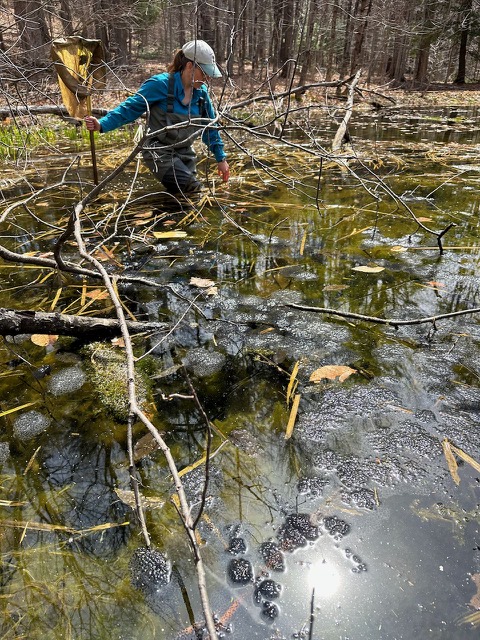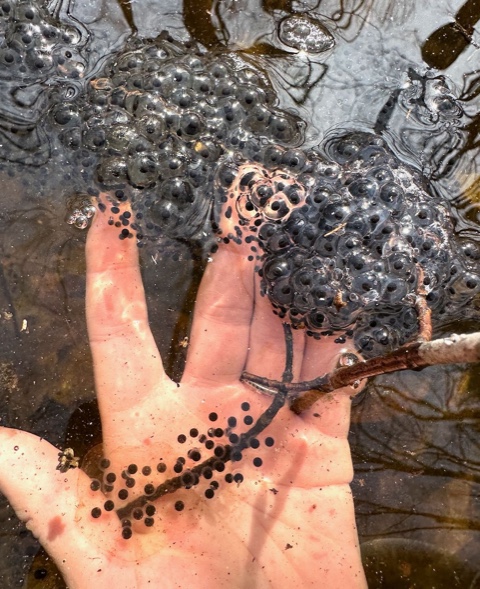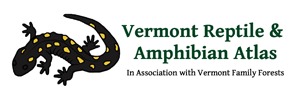
Herp Update: Current Herp Activity, Amphibians of Vermont Pocket Guide – April 15, 2023
Current Herp Activity
Herpers, this has been an unusual spring for amphibian migration. Here in the Lake Champlain Basin we had early migration of good numbers of Wood Frogs, and Blue-spotted, Spotted, and Four-toed Salamanders and then it dried out and warmed up. We have been hearing large choruses of Wood Frogs and Spring Peepers here in the lowlands. We know Wood Frogs will move even during a sunny day if they hear a chorus nearby. I am not sure when the Spring Peepers moved. We recently visited some pools in Brattleboro and it was interesting that there were lots of Wood Frog eggs (and there were more being laid while we were there), and lots of Jefferson Salamander egg-masses, but no Spotted Salamander egg-masses yet (see photos below). It appears that conditions dried up after some of the male Spotted Salamanders had moved, but before the females arrived. Jefferson Salamanders, Blue-spotted Salamanders, and Wood Frogs are the earliest to move and lay their eggs, but we usually see at least a few Spotted Salamander egg masses show up early in the season with those species. So, it will be really interesting to see what amphibians migrate this coming Monday night. The current forecast for my area, looks good for amphibian migration with very warm (over 50 F) and wet conditions shortly after dark. Of course, higher elevations and northern latitudes just lost their snow cover, so for them, it will be the first of the amphibian migrations. Here in the valley, I think we will see both early-season species and some warmer-season species moving together.
Some friends, family, and I went for a paddle this morning and heard lots of calling Northern Leopard Frogs in the Otter Creek floodplains. The swamps and fields are filled with the meltwater from the snow in the mountains. Otter Creek gets high enough in the spring that it flows backward up into many of its tributaries and fills their floodplains. Northern Leopard Frogs use these flooded and open lowlands to breed.
Sue Staats reported the first Snapping Turtles on the roads. Since it is so early in the season, I do not believe that these were females looking for egg-laying locations, but rather they were turtles that had left their ponds to overwinter in a nearby stream and they were moving back into their feeding ponds. Sadly, one of them got hit and killed while trying to cross the road.
Rick Armitage reported the first Eastern Musk Turtle of the year down in West Haven and Common Watersnake, DeKay’s Brownsnake, and Red-bellied Snake have now been reported as well.
Don’t miss out on our Amphibians of Vermont Pocket Guide
We have received many orders for our new Amphibians of Vermont pocket guide that was produced in collaboration with Teage O’Connor of Crow’s Path. This is the first and only guide for the amphibians of Vermont. This small folding guide easily fits in your pocket and has detailed color paintings of all of Vermont’s frogs and salamanders along with our latest distribution maps and descriptions. You can see and order it ($15) through our website at: https://www.vtherpatlas.org/support-and-funding/amphibian-field-guide/
Attached Photos
I have attached some photos from our field excursion in Brattleboro this week. The first one shows herpetologist Kate Kelly in a large vernal pool behind the Wood Frog egg masses, but searching for Spotted Salamander masses (none found). The second photo shows a Jefferson Salamander egg mass at the bottom of the photo with Wood Frog egg masses at the top of the photo. This is a relatively large Jefferson Salamander egg mass with over 50 eggs in the mass. Its elongated shape, and runny texture (only visible when you hold it out of the water), tell us it is a large Jeff mass versus a small Spotted Salamander mass. Thanks to Rosy Metcalfe for the photos.
Happy herping!



